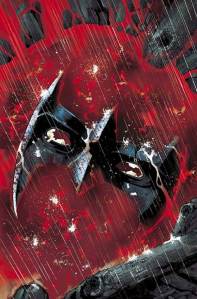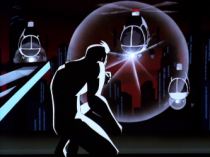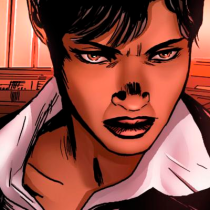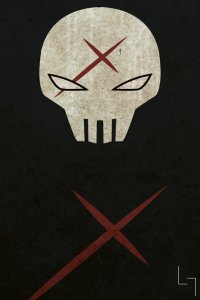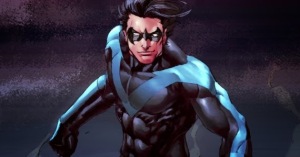 If you’ve been listening closely on a few of the more recent podcasts of That Girl with the Curls, you might have noticed I’ve been talking a lot about Storm. She’s one of my favorite X-Men and, if you haven’t listened to the episodes linked, her trading card back in the early to mid-nineties was one of my most prized possession. Whenever my mom took me and my sister to the local game shop – we didn’t exactly have a comic book store close by to my recollection – I always asked (or begged) for another pack of X-Men cards. I was in love with the 1992 cartoon and I was infatuated with Storm. More accurately, I wanted to be Storm. Not only did she have what I believed to be the best mutant powers ever, but as the cartoon progressed I became wrapped up in her story. Like many of the X-Men, and villains, featured in the cartoon, Storm was fleshed out as a character, showing a wide range of emotions fueled by her past and her present position as one of the most powerful mutants on the X-Men roster.
If you’ve been listening closely on a few of the more recent podcasts of That Girl with the Curls, you might have noticed I’ve been talking a lot about Storm. She’s one of my favorite X-Men and, if you haven’t listened to the episodes linked, her trading card back in the early to mid-nineties was one of my most prized possession. Whenever my mom took me and my sister to the local game shop – we didn’t exactly have a comic book store close by to my recollection – I always asked (or begged) for another pack of X-Men cards. I was in love with the 1992 cartoon and I was infatuated with Storm. More accurately, I wanted to be Storm. Not only did she have what I believed to be the best mutant powers ever, but as the cartoon progressed I became wrapped up in her story. Like many of the X-Men, and villains, featured in the cartoon, Storm was fleshed out as a character, showing a wide range of emotions fueled by her past and her present position as one of the most powerful mutants on the X-Men roster.
Goddess, thief, mutant, queen, leader, friend, lover, and hero; Ororo Munroe, aka Storm, was introduced, along with Wolverine, Nightcrawler, Colossus, Thunderbird, and Banshee in Giant-Size X-Men #1 (May, 1975) as part of a new diverse generation of mutants created by writer Len Wein and artist Dave Cockram. When Chris Claremont took over writing for Uncanny X-Men from Wein, he established Storm’s backstory and continued to feature her as a prominent character for the next sixteen years. Since her first appearance, Storm has been in every iteration of the  X-Men to date; cartoons/anime, movies, and video games have all utilized Storm not just as a powerful mutant but also as a valued team member and friend. However, in the nearly four decades she’s been part of the X-Men Universe, she’s never had a solo book until now and it’s already facing cancellation after only five issues.
X-Men to date; cartoons/anime, movies, and video games have all utilized Storm not just as a powerful mutant but also as a valued team member and friend. However, in the nearly four decades she’s been part of the X-Men Universe, she’s never had a solo book until now and it’s already facing cancellation after only five issues.
Currently being written by Greg Pak with pencils by Victor Ibañez and colors by Ruth Redmond, Storm’s solo book has finally taken the Mistress of the Elements out from under the greater umbrella of the X-Men team to explore her as an individual on her own terms. Yes, she’s still as much involved with the team as ever but Pak uses her relationships, past and present, to key us into what makes Storm so significant and so different. In the five issues thus far, Pak has firmly established Storm as a defender of anyone in need who’s grown tired of working within systems (societal and political) that prevent her from helping others and doing what’s right. As she tells Wolverine, she doesn’t want to hold back anymore and Pak succeeds in making each issue function partially as a one-shot but tied together through the  overarching theme of Storm’s personal journey to make good on her statement. Much of that journey means going back to her roots in Africa, making her book significant on a cultural level. Africa is a hotbed of socio-economic and political conflicts, so putting Storm in the midst of these problems makes sense and gives her an added dimension of relevance.
overarching theme of Storm’s personal journey to make good on her statement. Much of that journey means going back to her roots in Africa, making her book significant on a cultural level. Africa is a hotbed of socio-economic and political conflicts, so putting Storm in the midst of these problems makes sense and gives her an added dimension of relevance.
But really it’s the diversity angle I want to stress here because it’s at the heart of the #SaveStorm campaign started not too long ago in an effort to keep the book afloat. In the wake of Marvel’s cancellation of Elektra and She-Hulk‘s solo books, the common denominator was low sales. As Brett White at Comic Book Resources pointed out:
According to the October sales charts, “She-Hulk” #9 sold 21,418 physical copies and “Elektra” #7 sold 15,021. You know what series sits between those two terminated ongoings? “Storm.” The fourth issue sold 19,862 copies, which, if “She-Hulk” and “Elektra’s” ultimate fates are to be used as proof, puts it in danger of being cancelled.
 Problematic to this entire situation is the way in which copies are being counted. The October sales chart only covers physical copies sold to retailers in North America. Sales from countries outside North America and digital sales aren’t factored into the charts, making the numbers unreliable in their representation of the actual market of readers. But if these are the numbers Marvel is using to justify cancellations, then we have to work within the same parameters.
Problematic to this entire situation is the way in which copies are being counted. The October sales chart only covers physical copies sold to retailers in North America. Sales from countries outside North America and digital sales aren’t factored into the charts, making the numbers unreliable in their representation of the actual market of readers. But if these are the numbers Marvel is using to justify cancellations, then we have to work within the same parameters.
Are the low sales the result of terrible marketing? Personally, I found out about the book when maybe one or two websites mentioned it, but I can’t recall any huge push from Marvel. Then again, a lot of the solo books have fallen by the wayside mostly due to event books taking precedence. It’s still surprising how little attention she’s received given that Storm is one of the most recognizable characters in the X-Men universe, if not Marvel as a whole. She was Marvel’s first major black female superhero and one would think they’d try to market the hell out of her solo book. Then again, there’s been a lot of speculation about how Marvel has been handling titles with characters they don’t have the rights to for their cinematic universe. Just sayin’.
Is it the readers? I doubt Marvel would give the greenlight on a solo book unless there was enough interest in the character to warrant hiring the talent and spending the money to bring the book to fruition. But, as stated previously, event books are the company’s bread and butter, and with the glut of comics coming out from Marvel, DC, Image, IDW, Dark Horse, Boom!, Archie, and other independent publishers, readers need to decide where to spend their money. This means they often purchase books they’ve always bought instead of opting for something new, especially if they’re working with limited funds.
Is it the character? Popularity doesn’t necessarily mean dollar signs and there could definitely be a bit of mental gymnastics going on in the minds of readers trying to justify not buying the book. Storm, as part of the X-Men, still appears in several titles and she’s a regular participant in the crossover events due to her affiliations with multiple teams. It’s easy to think, “Well, she’s in these other books, so I’m still going to have Storm but also all these other characters.” Then again, Wolverine’s been around for the same amount of time and he was (RIP Logan) in almost every book Marvel could stuff him into. Personally, I don’t think it’s a gender or race issue in terms of the lack of interest or cancellation, but it is important in terms of representation in comic books. Diversity is integral to the survival of the comic book industry, not just in the creative teams, but in the characters put front and center. Storm  is on par with Wonder Woman as a character who inspires others. Her strength, compassion, and wisdom, coupled with her very human flaws, make her relatable to readers of all ages, races, and genders. Featuring her as a major player and representative of the Marvel brand, however, gives validation not just to the character but to those who identify with her yet feel overlooked.
is on par with Wonder Woman as a character who inspires others. Her strength, compassion, and wisdom, coupled with her very human flaws, make her relatable to readers of all ages, races, and genders. Featuring her as a major player and representative of the Marvel brand, however, gives validation not just to the character but to those who identify with her yet feel overlooked.
The question then becomes: Is that enough? Marvel is a company and numbers are what matter to companies. If a book isn’t selling, even if the higher-ups love it for all the right reasons, it will eventually boil down to numbers. So, for now, all we can do is support the hell out of Storm. Buy or order it from your local comic book store, buy it on Comixology, tweet about the book with the hashtag #SaveStorm, go on Tumblr, shove a copy of the book into the hands of your friends and families. Help Storm because she’d do her damnedest to help you.














